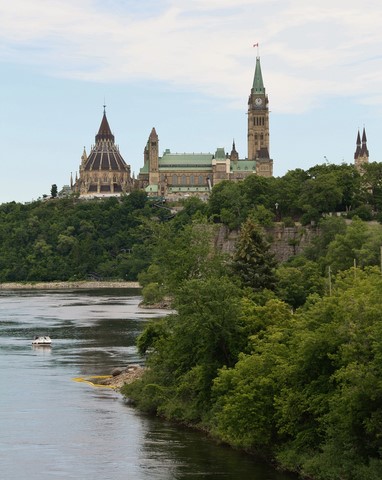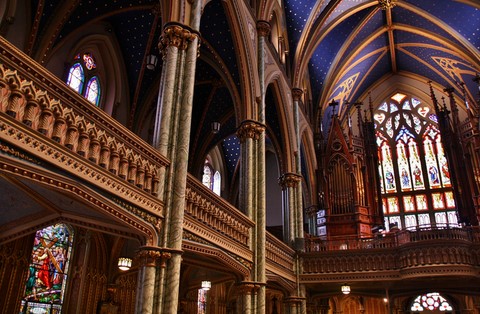Ottawa, «Bytown»
You can click on pictures to enlarge them
Located in Ontario at the border with Quebec, it constitutes with Gatineau – sitting on the Quebec bank of the Ottawa River – the region of the national capital. The Portage Bridge, which connects both cities, is like a link between both states, even between the Anglophone Canada and the francophone Canada. Besides, you will be surprised by the number of people who speak easily the language of Molière in the streets of Ottawa. Founded in the early 19th century in a dominant Victorian style, it surprises in many ways. Though it is the capital of the second largest country in the world, it is a human-sized city that you can discover on foot or by bike: certainly, it spreads out administratively on 2790 m², but its purely urban part has a relatively modest size and its population is just under one million. Its green areas, numerous and wide, make it much enjoyable, as well as its water courses: the Ottawa River, obviously, but also the Rideau River, the Rideau Canal, Lake Dow and Lake McKay. The architecture there is very rich, and its historic buildings give it additional character and value. Cultural life is very active there, with numerous much varied museums. Restaurants and shops are quality. Its cosmopolitanism and its very special sweetness of living make you feel fine there from the first moments.
Parliament Hill & Upper Town
The famous Parliament Hill (photo) proudly overlooks the city and the Ottawa River. There, three buildings in Gothic Revival style from the 19th century rise on a wide garden. The Center Block houses the House of Commons and the Senate. It is perfectly symmetric and on its center, the 93 meters high Peace Tower includes a carillon with 53 bells. It is home to the Memorial Chamber. Nearby, the beautiful Library of Parliament is a jewel of architecture. Made of sandstone blocks, it has 16 sides and its three-level copper roof forms a vault. Its arched windows, its flying buttresses and its turrets complete the picture. Its interior is decorated with white pine paneling and it houses a marble statue of Queen Victoria. The asymmetric Eastern Block is made of cut stones of various colors. It also includes arched windows, as well as gargoyles and statues. It is home to offices of senators and members of the House of Common. As for the Western Block, it was extended significantly since it was built: a wing was notably added, as well as the colossal Mackenzie Tower. Every morning at 10:00 A.M. from late June to late August takes place the changing of the guard of soldiers with red uniforms and bear skin headdresses, like the Royal Guards in London.
At the foot of the hill, the Bytown Museum traces the steps of the construction of the city and the Rideau Canal. On the banks of the latter, the Confederation Park is a wide and pleasant green area that offers various activities and events; the most prestigious is the Ottawa Jazz Festival. The colossal Confederation Building in Gothic Revival style has one central tower and two wings. The elegant Langevin Building was erected in the late 19th century in Second Empire style. It houses the Office of the Prime Minister and the Privy Council Office. The Saint-Andrew Presbyterian Church, from the 19th century, is characterized by its rather high spire. Just opposite stands the Supreme Court of Canada, built in 1938 in Art Deco style. Nice red brick Victorian houses in Queen Anne style from the early 20th century rise in a section of Queen Street, beautiful well preserved remains of the Colonial era. The interior of the Christ Church Cathedral, in Neo-Gothic style, is dotted with white marble columns and nice stained glass windows. Not far stands the Saint-Peter’s Lutherian Church, built in the mid 20th century with Nepean sandstone in English Gothic style. The Library and Archives Canada, which is full of very interesting documents about the country, houses temporary exhibitions. Isolated on the banks of the Ottawa River, the Canadian Museum of War displays its avant-gardist architecture that clashes with the rest of the cityscape.
See:
· Parliament Hill
· Bytown Museum
· Historic Site of the Center Block
· National Arts Centre
· Confederation Park
· Confederation Building
· Langevin Building
· Saint-Andrew Presbyterian Church
· Supreme Court of Canada
· Christ Church Cathedral
· Saint-Peter’s Lutherian Church
· Library and Archives Canada
· Canadian Museum of War
Lower Town & Sandy Hill
In Lower Town, ByWard Market is well known for its good restaurants and its atmosphere. The covered market enjoys an excellent reputation thanks to its stalls of fruits and vegetables, its worldwide food outlets and its local craftsmen. In the surroundings, shops, bars and restaurants abound. It is one of the liveliest and the most cosmopolitan district in the city.
The other remarkable attraction in the district is naturally the National Gallery of Canada, an imposing modern building that houses an amazing collection of artworks. In front of it stands a bronze sculpture of a giant spider which pretty little name is… Mama!!! It is a famous work from the artist Louise Bourgeois. On the other side of the square rises the Basilica Cathedral Our-Lady of Ottawa (photo). It enjoys a sumptuous interior decoration, with its worked wood altar and its beautiful statues.
Major’s Hill Park, is a pleasant green area on the banks of the Ottawa River, on the outskirts of which you can admire the Connaught Building, built in the early 20th century in Gothic Revival and Tudor Revival styles, and the Fairmont Château Laurier, splendid luxury hotel from the same period. Its entrance hall has a breathtaking beauty. Nearby stands the amazing locks station. It is 500 meters long and 100 meters wide; it includes eight successive locks, which total height is 24 meters at the entrance of the Rideau Canal. It was a real feat of construction technologies, an innovative and cutting-edge system at its design stage. Besides, the Historic Site of the Rideau Canal preserves that remarkable waterway that links the Ottawa River to Lake Ontario at Kingston over 200 kilometers. Very pleasant pedestrian paths and cycle lanes line it, as well as green areas. There you can practice kayaking or canoeing. In the winter, it becomes the longest ice rink in the world (7.8 kilometers long!)
In Sandy Hill stands the Ottawa University, bilingual public establishment founded in 1848. Various architectural styles mix, for buildings were erected over different periods. Not far stands the National Historic Site of Laurier House, open to the visit. It is the ancient home of Sir Wilfried Laurier, who was the Prime Minister of Canada. It was finally bequeathed to the National Heritage.
See:
· ByWard Market
· National Gallery of Canada
· «Mama» sculpture
· Basilica Cathedral Our-Lady of Ottawa
· Royal Canadian Mint
· Major’s Hill Park
· Connaught Building
· Fairmont Château Laurier
· Locks station
· Historic Site of the Rideau Canal
· Ottawa University
· National Historic Site of Laurier House
The Center & The Glebe
In Centretown district (photo), shops and restaurants abound in the heart of very lively and pleasant streets, notably Elgin Street. The Canadian Museum of Nature, massive Neo-Gothic stone building with a British influence, displays carved animal faces on its façades. It is notably home to an amazing whale skeleton and various dinosaur skeletons. The central hall is topped with a colossal glass cage that houses a giant sculpture of a jellyfish. Themes are much varied.
As you walk up the Rideau Canal, you linger in residential streets where numerous Victorian houses stand, and which is dotted with nice urban parks. The fit out banks of the canal are much pleasant. The watercourse forms a bend at the end of which a long straight line offers a perspective that opens to the famous Parliament Hill. The ideal place to enjoy it is Corktown footbridge.
The entrance gate of Chinatown is sumptuous. Much refined and colored, it tempts visitors to enter that district which is fairly small, but filled with an exotic charm. Restaurants abound there. However, it is appropriate to take the time to choose the one you are going to eat at, because if some of them are advisable, some others are rather of medium quality. The parade of the Chinese New Year is obviously a highlight event.
Little Italy is filled with shops and restaurants. Works of arts also have their place, notably murals. The most remarkable are under the Queensway viaduct. They trace the life of the Italian community in the Canadian capital. Bambini, the surprising sculpture by Chantal Gaudet, represents children with cheerful and enthusiastic looks. Italy is famous for its pasta, its pizzas… and its coffee. For that purpose, the Bridgehead roaster allows lovers a monthly visit at the end of which the roasting process will no longer be a mystery to them. Of course, a tasting on a terrace is possible. Finally, the Italian Week and its festivities is the event in the district you should not miss.
More south, The Glebe is a very pleasant cosmopolitan district with a varied architecture. Shops there are diversified and quality. Landsdowne Park is the historic exhibition center of Ottawa. That green area of more than 7 acres hosts various events, festivals and spectacles. The amazing Aberdeen Pavillon is an exhibition building that dates from the very early 19th century. Its exterior architecture is much refined with a dome, onion domes and turrets. The interior is much sunny thanks to the presence of numerous windows. The TD Place is the stadium that hosts the football team and the soccer team.
Lake Dow is an artificial lake where you can practice kayaking or canoeing like on the Rideau Canal, as well as pedal-boat. It has also a cycle lane. Nearby, the Commissioners Park must be absolutely visited in the springtime, where it gets covered with a wide flowerbed of multicolored tulips. The Arboretum and the Fletcher Wildlife Garden deserve to linger too, as well as the Canada Agriculture and Food Museum and its created farm, for young and old alike.
See:
· Centretown
· Canadian Museum of Nature
· Chinatown
· Little Italy
· Glebe Community Centre
· Landsdowne Park
· Aberdeen Pavillon
· TD Place
· Lake Dow
· Commissioners Park
· Arboretum and Fletcher Wildlife Garden
· Canada Agriculture and Food Museum
Vanier & The East
The powerful Rideau Falls (photo) are located at the confluence of the Rideau River into the Ottawa River. They are more than 10 meters high. Sussex Drive follows the Ottawa River. Imposing opulent residences run along there in the heart of wide properties. You can notably admire the French Embassy, the Residence of the British High Commissioner – where a London phone booth was put up on the grass – and the Official Residence of the Prime Minister of Canada, huge stone house from the 19th century. The Rideau Hall and its splendid 40 hectares garden is worth a visit: that sumptuous residence belongs to the Governor General of Canada. Some of the very numerous trees were planted by visiting heads of states from around the world. Try to be there at the time of the changing of the guard of soldiers. Obviously, it is less spectacular than the one that takes place at Parliament Hill, but it is nevertheless a great time.
The Muséoparc Vanier, with francophone vocation, houses numerous exhibitions. It is located in Richelieu Park and enjoys sap houses open to the visit in March and April. The springtime is the perfect season to visit Rockcliffe Park, when its garden (Rockcliffe Rockeries) gets covered with numerous flowers. It also has panoramic viewpoints that offer uninterrupted views.
Built on Rockcliffe Historic Airport, the huge Canada Aviation and Space Museum teaches you a lot about the evolution of aviation and aerospace. The collection of planes is simply breathtaking. Biplane flights or helicopter flights are possible, but you can content yourselves with the flight simulator.
See:
· Rideau Falls
· French Embassy
· Residence of the British High Commissioner
· Official Residence of the Prime Minister of Canada
· Rideau Hall
· Muséoparc Vanier
· Rockcliffe Park
· Canada Aviation and Space Museum
The West
Young and vibrant, Hintonburg is the bohemian and artistic district of the city. It is overlooked by the clock tower of Saint Francis of Assisi Church, built in the early 20th century. There you can find studios and theaters, but art galleries are the ones that really abound. The most remarkable is Orange Art Gallery in the heart of the City Center, which is located at the edge of Chinatown. Markets, taverns and tearooms complete the picture. The numerous cultural events draw crowds.
There are many art galleries in Wellington Village district as well, also famous for its trendy shops.
Westboro is more peaceful and welcomes a less young and well-off population. It is nevertheless pleasant and its outdoor shops are much attractive. The Old Nepean Town Hall, nice stone building, was built in the 19th century. As the name suggests, it is the former city hall of Nepean, located south of Ottawa. Indeed, Westboro was annexed to the capital in 1950. Winston Square is a modern urban park, scene of numerous artisanal and musical events, especially in the summer.
See:
· Saint Francis of Assisi Church
· Hintonburg Community Centre
· City Center
· Orange Art Gallery
· Parkdale Market & Park
· Old Nepean Town Hall
· Winston Square
Published on March 28th 2021







